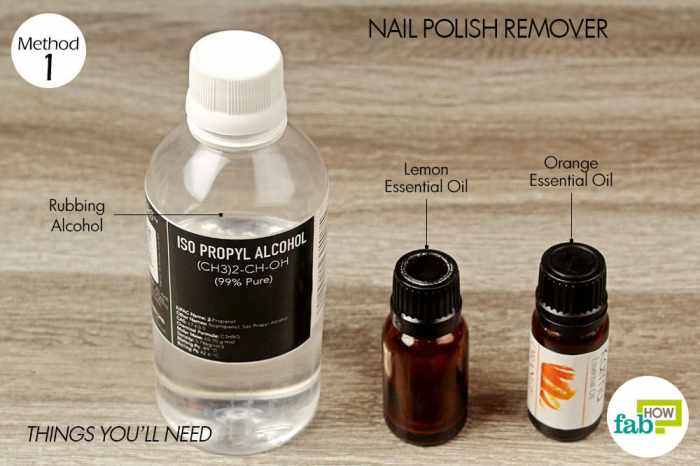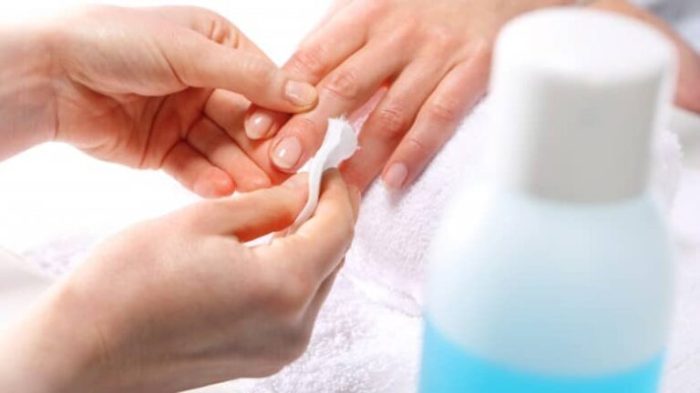Can Alcohol Remove Nail Polish?
Alcohol as a Nail Polish Remover: Can Alcohol Remove Nail Polish
Can alcohol remove nail polish – Removing nail polish can be a simple task, and while commercial removers are readily available, exploring alternative methods can be both insightful and practical. This article delves into the effectiveness of using various types of alcohol for nail polish removal, examining its advantages, disadvantages, and comparison with conventional methods. We will explore the chemical interactions, safety precautions, and potential risks involved.
Alcohol Types and Nail Polish Removal Effectiveness
Different types of alcohol possess varying levels of effectiveness in dissolving nail polish. This is largely due to differences in their chemical structures and properties, particularly their polarity and ability to interact with the solvents in nail polish.
| Alcohol Type | Effectiveness | Evaporation Rate | Potential Nail Damage |
|---|---|---|---|
| Isopropyl Alcohol (IPA) | High (especially 91% or higher) | Moderate | Low, if used properly and sparingly. |
| Rubbing Alcohol (typically IPA) | High (effectiveness depends on the concentration of IPA) | Moderate | Low, if used properly and sparingly. |
| Ethanol | Moderate to High | Fast | Low, but may dry nails more quickly than IPA. |
Isopropyl alcohol (IPA), commonly found as rubbing alcohol, is generally the most effective due to its ability to readily dissolve many of the common solvents in nail polish. Ethanol, while effective, evaporates more quickly, potentially requiring more applications. The concentration of the alcohol significantly impacts its effectiveness; higher concentrations generally lead to faster and more complete removal.
The Removal Process: Methods and Techniques

Source: fabhow.com
Using alcohol to remove nail polish requires a careful approach to ensure both effectiveness and safety. The following steps and methods will guide you through the process.
- Gather your supplies: cotton balls or pads, the chosen alcohol, and a small bowl (optional, for soaking).
- Apply a small amount of alcohol to a cotton ball or pad.
- Gently hold the cotton ball against the nail polish, allowing the alcohol to soften and dissolve the polish.
- Gently wipe away the dissolved polish. Repeat as needed.
- Wash your hands thoroughly to remove any remaining alcohol.
- Moisturize your hands and nails to counteract potential dryness.
Several methods can be employed for applying the alcohol:
- Direct application with a cotton ball or pad.
- Soaking a cotton pad in alcohol and applying it to the nail.
- Spraying the alcohol onto the nails (use a fine mist to avoid over-saturation).
Proper disposal of alcohol-soaked materials is crucial. Discard them in a sealed, non-flammable container to prevent accidental fires or spills.
While alcohol can remove nail polish, it’s often harsh on your nails. For a gentler approach and a stunning finish, consider using a specialized remover or even exploring alternative polish options like those offered by your nails but better polish , which might provide a longer-lasting and healthier result. Ultimately, the best method for removing nail polish depends on your personal preference and nail health priorities.
Nail Polish Composition and Alcohol Interaction
Nail polish is a complex mixture of various chemicals. Understanding these components helps explain how alcohol interacts with them to achieve removal.
| Nail Polish Type | Composition | Alcohol Removal Effectiveness | Notes |
|---|---|---|---|
| Regular Nail Polish | Solvents (e.g., ethyl acetate, butyl acetate), polymers (e.g., nitrocellulose), pigments, additives | Generally High (with IPA) | Easily removed with most alcohol types. |
| Gel Nail Polish | Similar to regular polish but with added photoinitiators and often requires UV curing | Low | Requires specialized removal methods; alcohol alone is ineffective. |
| Glitter Nail Polish | Regular polish base with added glitter particles | Moderate to Low | Glitter particles may require additional scrubbing; alcohol may not fully remove all glitter. |
Solvents in nail polish are the primary target of alcohol-based removal. Alcohol dissolves these solvents, weakening the polymer structure and allowing the polish to be easily wiped away. The type and concentration of solvents will influence the effectiveness of alcohol.
Potential Risks and Side Effects
While generally safe, using alcohol to remove nail polish carries some potential risks. Prolonged or improper use can lead to negative consequences.
Potential risks include skin irritation, dryness, and even nail damage if used excessively or if the alcohol is too concentrated. To minimize these risks, always use a low concentration of alcohol, avoid prolonged exposure, and moisturize your hands and nails after removal.
Comparison with Commercial Nail Polish Removers

Source: rubbing-alcohol.com
| Factor | Alcohol | Commercial Remover |
|---|---|---|
| Cost | Generally lower | Variable, can be higher |
| Speed | Moderate | Generally faster |
| Potential Nail Damage | Low, with proper use | Low to moderate, depending on ingredients |
Commercial removers often contain additional ingredients that enhance their effectiveness and may also condition the nails. However, some commercial removers contain harsh chemicals that can damage nails over time. Alcohol, used judiciously, offers a gentler alternative in certain situations.
Illustrative Examples of Nail Polish Removal with Alcohol, Can alcohol remove nail polish
The effectiveness of alcohol in nail polish removal varies depending on the type of polish and the method used.
Scenario 1: Regular Red Nail Polish. Using 70% isopropyl alcohol and a cotton ball, the polish was easily removed in a few swipes. The process was quick and efficient, leaving the nails clean and undamaged.
Scenario 2: Glitter Nail Polish. Removing glitter polish with 91% isopropyl alcohol required more effort and multiple applications. While the alcohol dissolved the base coat, the glitter particles required more careful scrubbing to fully remove.
Scenario 3: Sensitive Skin Area. When removing polish near the cuticle, apply the alcohol gently using a small cotton swab to avoid irritating the delicate skin. Avoid harsh scrubbing and allow the alcohol to work slowly.
Improper Technique Example: Using a highly concentrated alcohol without proper ventilation can cause skin irritation and dryness. Aggressive scrubbing can damage the nail bed, potentially leading to chipping or peeling.
User Queries
Can I use any type of alcohol to remove nail polish?
No, not all alcohols are equally effective. Isopropyl alcohol (rubbing alcohol) is generally the most effective, while others may be less potent or even ineffective.
Will using alcohol damage my nails?
Frequent or prolonged use of alcohol can dry out and weaken nails. It’s best used sparingly and with appropriate precautions.
What should I do if I get alcohol in my eyes?
Immediately flush your eyes with plenty of cool water for at least 15 minutes and seek medical attention if irritation persists.
Is alcohol-based removal better than commercial removers?
It depends. Alcohol can be a cheaper alternative, but commercial removers are often faster and less likely to damage nails if used correctly.
















